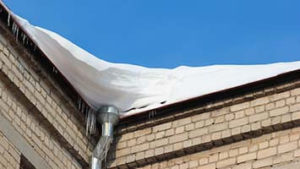 Snow and ice can take a toll on any building.
Snow and ice can take a toll on any building.
Temperature extremes from summer to winter place a heavy burden on the buildings we live in and the places we work. With little warning, gusting winds, heavy snow and bitter temperatures can create a weather event that could collapse your roof, freeze and rupture your piping and cause havoc in your life.
But prudent loss control strategies you implement before winter can protect your home or business and minimize the impact of weather-related property damage, business interruption and other losses.
Cold weather states are not the only places vulnerable to extreme winter weather losses. In reality, property owners in moderate climate states not normally associated with harsh winter weather tend to suffer the most costly losses because they are typically unprepared for extreme conditions. The winter of 2014 was one of the costliest since 1980, with $1.5 billion in insured losses filed between January 1 and February 21, 2014, alone, according to the Insurance Information Institute.
PREPARING BUILDINGS
Be prepared by keeping on top of routine building maintenance. Look for any evidence of previous damage to your building’s structure, paying special attention to damaged roof material or equipment that may need repair or replacement. Also take note of any areas that could be unstable during severe winter weather.
- Maintain roofs in good condition. Repair leaks, secure flashing and clear debris from the roof, roof drains, downspouts and overflow outlets.
- Check that gutters and downspouts are secured to buildings and clear of leaves and debris. Were they iced over during the previous winter? Consider installing heat trace (electric cable or tape) to prevent major icicles and ice dams.
- Assure that all building openings are weather-tight to prevent cold air that could cause water pipes or fire protection systems to freeze. If you recently built an addition or renovated, how were existing utilities – especially water and sprinkler piping – protected from frigid temperatures?
- Test any low-building-temperature alarms.
PREVENTING BUILDING COLLAPSE
Heavy snow, freezing rain or a series of constant rain showers and wind can cause precipitation to accumulate, leading to roof failure. Blocked roof drains and overflows can cause precipitation to accumulate and overload the roof. Many older buildings that were not required to provide secondary overflow drainage, such as scuppers, do not provide adequate drainage when primary drains are blocked.
Collapses can damage the building and its contents, destroy fire protection systems and unleash dangerous live utilities, including electricity and flammable gases. These losses can be made worse by water damage from rain intrusion or broken water piping.
Consult with a qualified contractor to assess your roof condition before you experience a problem.
https://blog.cinfin.com/2016/12/06/winter-prep-prepare-building/